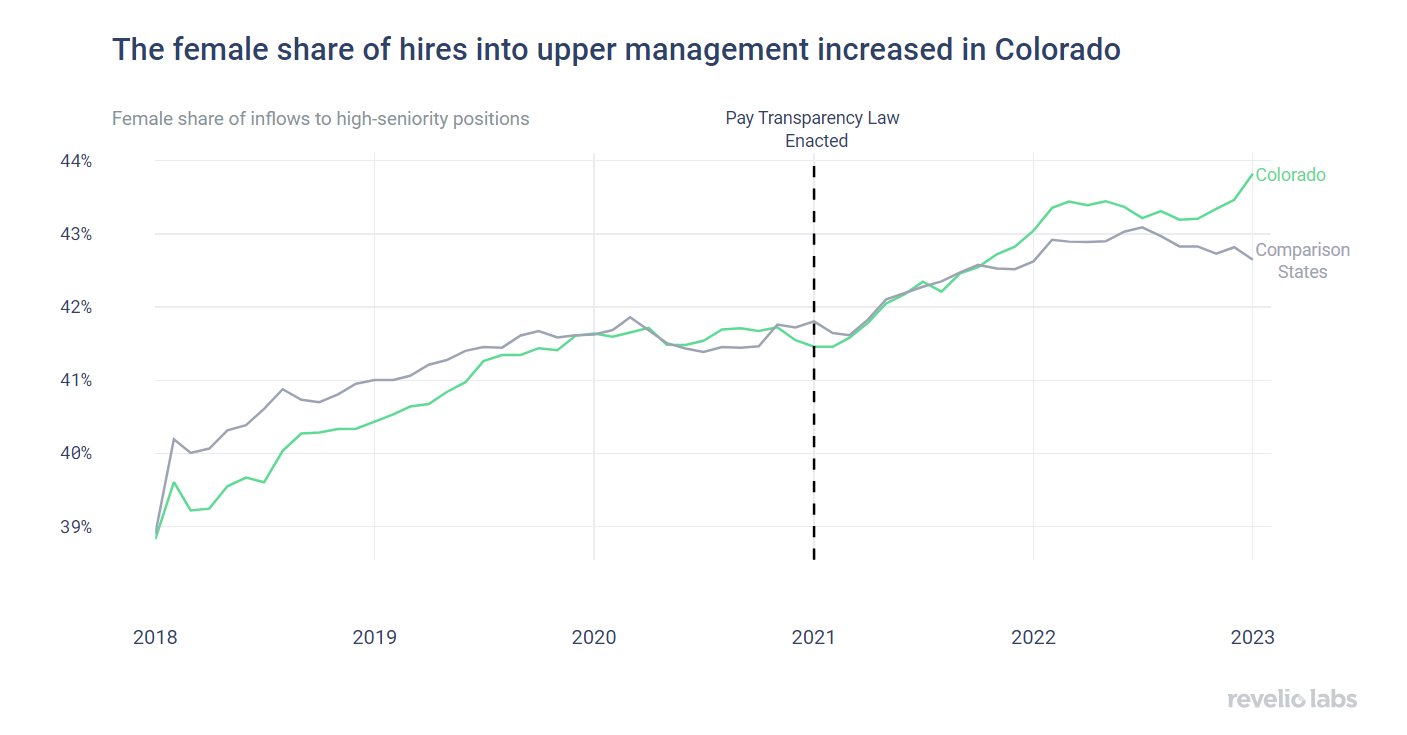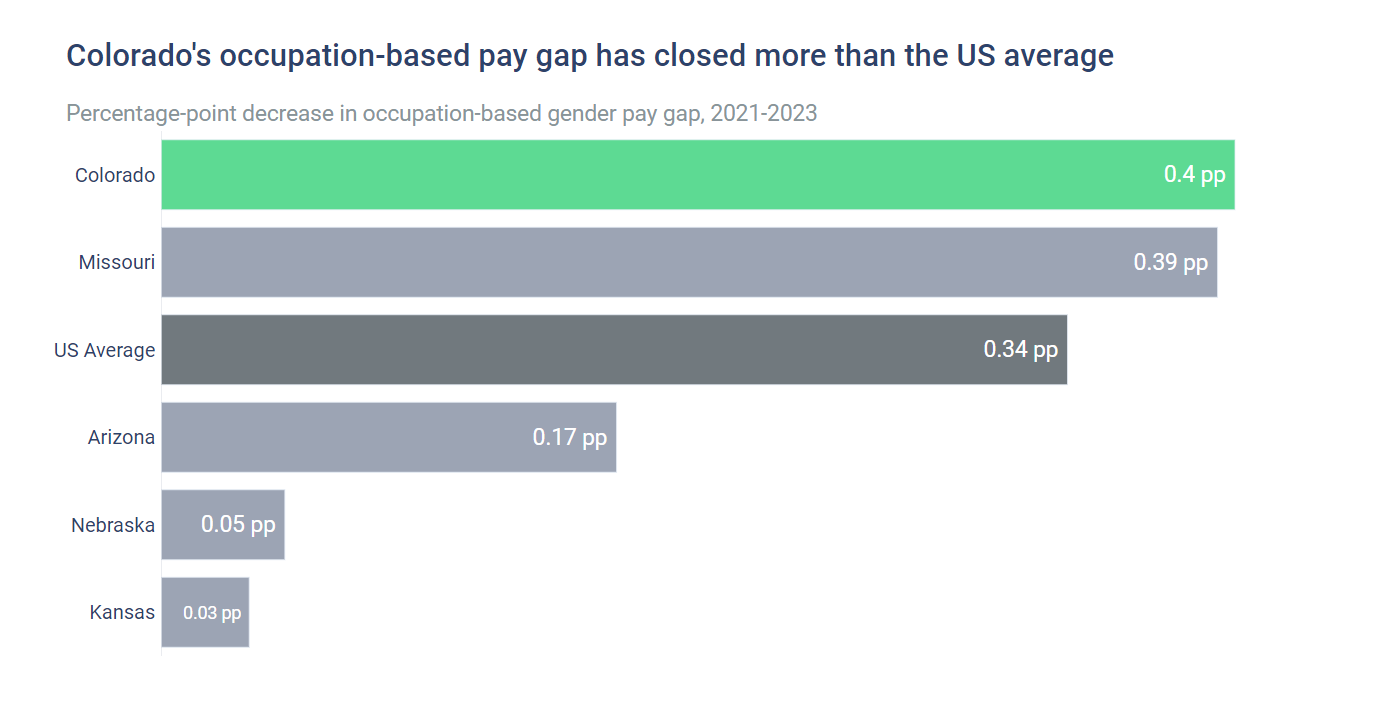
Source: https://www.reveliolabs.com/news/social/does-pay-transparency-help-close-the-gender-pay-gap/
In Colorado, where pay transparency has been in effect for over two years now, the share of women among hires into upper-management positions has increased.
By this time, you probably already know what day it is: Equal Pay Day. Don’t worry, this isn’t another rant on the pay gap, but rather an examination of a measure purported to address the problem, pay transparency laws. The hope is that through access to complete information on salary ranges, all employees and applicants will be better equipped to navigate salary negotiations with existing and potential employers. If men tend to negotiate salaries more aggressively, then explicit pay ranges remove some of the guesswork that has kept women from negotiating with the same confidence.
Additionally, by opening up conversations around compensation and career opportunities, pay transparency can empower people to make informed decisions or formulate career goals. Women may be encouraged to ask for promotions or choose higher-paying jobs.
In this week’s analysis, we look to Colorado, where pay transparency has been in effect for over two years now. We analyze its effects on the occupational component of the gender pay gap: How pay transparency impacts hiring and promotion decisions, and whether it impacts applicants’ behavior and occupational choices. We find that since the law was implemented, there has been an increase in female representation in high-seniority hires.

To evaluate the impacts of the law, we construct a group of states to compare against Colorado. We pick these states based on their similar initial female shares across job categories, as well as geographic proximity. Missouri, Arizona, Nebraska, Kansas, and South Dakota make up the group. While Colorado was lagging behind its peers in the share of female hires into upper-management before the introduction of pay transparency, it overtook the other states in 2022 and remains on a better trend. Of course, other factors that changed in Colorado around the same time may have contributed to this trend, too.
On the other hand, we find no evidence to suggest that pay transparency has impacted the share of women starting new positions in high-paying occupations, such as investment banking or software engineering. The difference between high-paying occupations and upper management in the previous plot is that occupations can be performed at different levels of seniority, and similarly, high-seniority positions exist across occupations. High-paying occupations, which we determine by ranking roles according to their average salary, are a question of vocational choice, while high-seniority roles are a question of climbing the corporate ladder. While Colorado caught up to the other states in terms of its share of women in high-paying occupations leading up to the law’s enactment, since then the share has declined and stayed below that of the other states.

Finally, we can look at the impact of the law on gender pay disparities. We want to be very clear: To avoid algorithmic bias, our salary model doesn’t distinguish between genders. This means that we cannot look at the textbook gender pay gap—that is, the difference in pay between men and women in the exact same job, at the same company, and in the same location. Instead, we can analyze what we call the “occupation-based gender pay gap.” This is the difference in pay that stems mainly from men being more likely to be in high-paying roles and high-seniority positions.
The occupation-based pay gap in Colorado has decreased by 0.4 percentage points since pay transparency was introduced, which is a little more than the US average and all of the comparison states. This decrease in the occupation-based pay-gap from 19.2% to 18.8%, or 19.2 cents down to 18.8 cents on the dollar, isn’t much to write home about on the surface, but it adds up over the course of a career. For example, assuming women have average lifetime earnings of 2 million USD, we can now expect a decrease in the earnings gap with men in Colorado by 8,000 USD. As we’ve seen, one factor contributing to this decrease is the increased share of women being hired into upper-management positions.

To learn more about the data behind this article and what Revelio Labs has to offer, visit https://www.reveliolabs.com/.







Sign up to receive our stories in your inbox.
Data is changing the speed of business. Investors, Corporations, and Governments are buying new, differentiated data to gain visibility make better decisions. Don't fall behind. Let us help.







Sign up to receive our stories in your inbox.
Data is changing the speed of business. Investors, Corporations, and Governments are buying new, differentiated data to gain visibility make better decisions. Don't fall behind. Let us help.